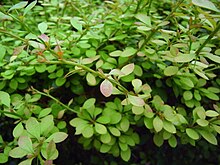User:Katewright54/sandbox
| Berberis Koreana | |
|---|---|

| |
| Any caption you like for the picture | |
| Scientific classification | |
| Kingdom: | |
| (unranked): | |
| (unranked): | |
| Order: | |
| Family: | |
| Genus: | |
| Species: | Koreana
|
| Binomial name | |
| Berberis Koreana | |
The Korean Barberry, Berberis Koreana, is deciduous shrub that can grow up for 5 feet tall (1.5m), is native to Korea, Eastern Asia and has been used as an ornamental tree in North America, South America, Canada and Europe. B. Koreana
Distribution
Berberis Koreana is native to Korea and Eastern Asia and has been recently used as an ornamental tree in the United States. The Berberis genus however, can be found in a variety of areas such as Canada, Eastern United States, China, Korea, Japan, and Europe.
Habitat and Ecology
B. Koreana is a deciduous shrub that is considered “hardy” which means it can tolerate temperatures as low as 5°F(-15°C). B. Koreana and also tolerate a range of soil types; it can be in a well-drained or moist soil. B. Koreana can be placed in full sun or part shade but does not prefer to be in full shade.[1]
Morphology

Individuals of this species are , deciduous shrubs that have berries that are purple to red in color. The leaf margins are dentate and have inflorescences racemes where the branchlets exhibit a reddish color. The simple, alternative leaves are elliptical or oval shape and are dark to medium green in color, they show pinnate venation, have a smooth edge that are 1-3’’ in length.[2]
Flowers and fruit

Flowers of “Berberis Koreana”, appear in clusters, are approximately 0.2’’ in length and are yellow in color when they bloom in the spring. B. Koreana has 0.2’’-0.3’’ egg-shaped, red to purple berries in the fall and winter months. The berries of the Berberis plants are edible but sour and are used in jams and jellies[3]
Food
The berries of the Berberis plants are edible but sour and are used in jams and jellies.
Medicinal Purposes
Roots were used by American Indians and settlers to help with upset stomachs, hemorrhages, tuberculosis, and eye trouble. Recently a study has shown that compounds that were synthesized from the Berberis Koreana has been able to show significant cytotoxicity against human tumor cell lines.[4] In another recent study, a compound was extracted from the trunk of the Berberis Koreana that was able to inhibit the growth of a skin melanoma. [5]
Intoxication

Several species of Berberis contain alkaloids such as berberine, canadine, columbamine, corypalmine, jatrorrhizine, and palmatine. These alkaloids are all very similar in chemical structure, but they all vary in the effects they have on humans. Protoberberine relaxes smooth muscle and causes a decrease in overall blood pressure. Berberine, at high dosages, has been known to cause seizures and inhibit enzymes. Berberis can have adverse side effects such as severe digestive tract irritation that includes nausea, vomiting, and diarrhea. The side effects are not life-threatening and can be treated.[6]
References
- ^ "NC State University".
- ^ "NC State University".
- ^ "Plants for the Future".
- ^ "Bioactivity-guided isolation of cytotoxic triterpenoids from the trunk of Berberis koreana".
- ^ Kim, Ki Hyun (30 November 2009). "Biphenyls from". Journal of Natural Products. 72 (11): 2061–2064. doi:10.1021/np900460j. Retrieved 2 July 2012.
{{cite journal}}: Unknown parameter|coauthors=ignored (|author=suggested) (help) - ^ Toxic Plants of North America. 2001. pp. 255–258. ISBN 978-0813822662.

